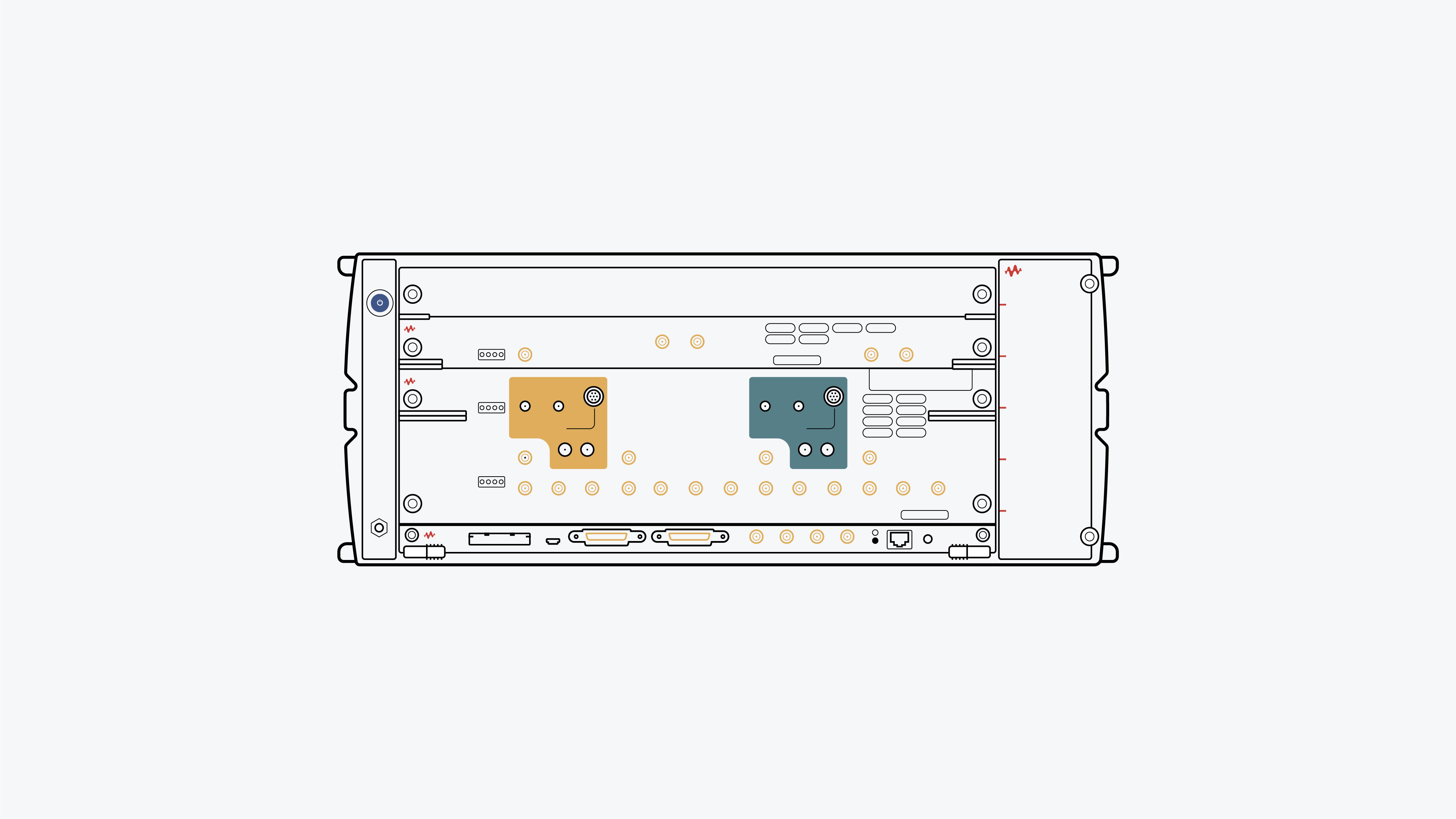How to Test PCIe® 5.0 Receiver Compliance


Setting up a receiver compliance test for a PCIe® 5.0 device
To ensure interoperability, PCIe 5.0 devices need to pass receiver compliance tests for certification by the PCI-Special Interest Group (PCI-SIG®). PCIe 5.0 technology encompasses both the base specification for silicon-level development and the card electromechanical (CEM) specification for motherboards and add-in cards. The physical layer (PHY) test specification provides guidance for testing using the CEM form factor.
Before conducting a receiver test, a bit error ratio tester (BERT) pattern generator must be calibrated with an oscilloscope to transmit a worst-case stress test signal. This process involves adding impairments, including incremental loss-induced intersymbol interference (ISI). After calibration, the receiver of the device under test (DUT) applies the test signal, measuring parameters such as the bit error ratio.

PCIe 5.0 receiver compliance test solution
Explore products in our PCIe 5.0 receiver compliance test solution
-
![D9020ASIA Advanced Signal Integrity Software (Crosstalk)]()
D9020ASIA Advanced Signal Integrity Software (Crosstalk)
-
![M8040A 64 GBaud High-Performance BERT]()
M8040A 64 GBaud High-Performance BERT
-
![N5991PC5A PCI Express 5 CEM Receiver Test Automation]()
N5991PC5A PCI Express 5 CEM Receiver Test Automation
-
![UXR0504B Infiniium UXR-Series Oscilloscope: 50 GHz, 4 Channels]()
UXR0504B Infiniium UXR-Series Oscilloscope: 50 GHz, 4 Channels


How to Test PCIe® 5.0 Receiver Compliance
D9020ASIA Advanced Signal Integrity Software (Crosstalk)
Advanced Signal Integrity Software (EQ, InfiniiSimAdv, Crosstalk)
Specs
| Debug & Analysis Software | |
| Connectivity & Usability Software |
|
| Compliance Test Applications |
|
| Select Oscilloscope Series |
|
| Software Type | |
| Applications |
|
| Compatible Instruments |


How to Test PCIe® 5.0 Receiver Compliance
M8040A 64 GBaud High-Performance BERT
The M8040A high performance BERT covers all flavors of 400 GbE standards testing with support for PAM4 and NRZ signals and data rates up to 64 GBaud
Specs
| Standards |
|
| Module Type |
|
| Amplitude | 0.9 Vpp @ 58 GBd |
| Clock data recovery built-in | Yes w/ adj loop bandwidth (16 MHz max) |
| Equalizer |
|
| FEC |
|
| Jitter Type |
|
| Line Coding |
|
| Link Training |
|
| Number of Channels |
|
| Type |
|
| Supported Data Rates | 64 Gbaud |
| Max sample rate | 64.8 GBd |


How to Test PCIe® 5.0 Receiver Compliance
N5991PC5A PCI Express 5 CEM Receiver Test Automation
The N5991PC5A is the receiver test automation software for bit error ratio testers, allowing you to test, debug and characterize PCI Express 5.0 CEM Add-In Cards and systems.
Specs
| License Types |
|
| Standards |
|
| Test Types | Conformance / Compliance Test |
| Compatible Instruments |
|


How to Test PCIe® 5.0 Receiver Compliance
UXR0504B Infiniium UXR-Series Oscilloscope: 50 GHz, 4 Channels
The UXR0504B is the 50 GHz, 4 channel, Infiniium UXR-Series real-time oscilloscope
Specs
| Bandwidth | 50 GHz |
| Max memory depth | 2 Gpts |
| Max sample rate | 256 GSa/s |
| Type |
|
Discover resources and insights
Additional resources for PCIe 5.0 receiver compliance testing
-
Programming guide
Discover the PCIe 5.0 Compliance Software Programming Guide
-
Reference guide
Learn How to Implement the PCIe 5.0 Automated Test Application
-
White paper
Introduction to PCIe 5.0 Test Challenges
-
Solution brief
Learn How to Simplify PCIe 5.0 Receiver Testing for Faster Compliance
-
Programming guide
Discover the PCIe 5.0 Compliance Software Programming Guide
-
Reference guide
Learn How to Implement the PCIe 5.0 Automated Test Application
-
White paper
Introduction to PCIe 5.0 Test Challenges
-
Solution brief
Learn How to Simplify PCIe 5.0 Receiver Testing for Faster Compliance
Related use cases
-
![How to Test USB4 Version 2.0 Receiver Compliance]() segmentation:business-unit/CSG,segmentation:campaign/Digital_High_Performance,segmentation:product-category/Oscilloscopes_BERTs_AWGs,keysight:product-lines/1a,segmentation:funnel/mofu,keysight:dtx/solutions/facets/development-area/high-speed-digital,keysight:dtx/solutions/facets/workflow-stage/conformance-and-compliance,keysight:dtx/solutions/facets/industry/wireline-communications,keysight:dtx/solutions/facets/design-and-test-product/bit-error-ratio-testers,segmentation:product-category/Oscilloscopes_BERTs_AWGs/BERTssegmentation:business-unit/CSG,segmentation:campaign/Digital_High_Performance,segmentation:product-category/Oscilloscopes_BERTs_AWGs,keysight:product-lines/1a,segmentation:funnel/mofu,keysight:dtx/solutions/facets/development-area/high-speed-digital,keysight:dtx/solutions/facets/workflow-stage/conformance-and-compliance,keysight:dtx/solutions/facets/industry/wireline-communications,keysight:dtx/solutions/facets/design-and-test-product/bit-error-ratio-testers,segmentation:product-category/Oscilloscopes_BERTs_AWGs/BERTssegmentation:business-unit/CSG,segmentation:campaign/Digital_High_Performance,segmentation:product-category/Oscilloscopes_BERTs_AWGs,keysight:product-lines/1a,segmentation:funnel/mofu,keysight:dtx/solutions/facets/development-area/high-speed-digital,keysight:dtx/solutions/facets/workflow-stage/conformance-and-compliance,keysight:dtx/solutions/facets/industry/wireline-communications,keysight:dtx/solutions/facets/design-and-test-product/bit-error-ratio-testers,segmentation:product-category/Oscilloscopes_BERTs_AWGs/BERTssegmentation:business-unit/CSG,segmentation:campaign/Digital_High_Performance,segmentation:product-category/Oscilloscopes_BERTs_AWGs,keysight:product-lines/1a,segmentation:funnel/mofu,keysight:dtx/solutions/facets/development-area/high-speed-digital,keysight:dtx/solutions/facets/workflow-stage/conformance-and-compliance,keysight:dtx/solutions/facets/industry/wireline-communications,keysight:dtx/solutions/facets/design-and-test-product/bit-error-ratio-testers,segmentation:product-category/Oscilloscopes_BERTs_AWGs/BERTssegmentation:business-unit/CSG,segmentation:campaign/Digital_High_Performance,segmentation:product-category/Oscilloscopes_BERTs_AWGs,keysight:product-lines/1a,segmentation:funnel/mofu,keysight:dtx/solutions/facets/development-area/high-speed-digital,keysight:dtx/solutions/facets/workflow-stage/conformance-and-compliance,keysight:dtx/solutions/facets/industry/wireline-communications,keysight:dtx/solutions/facets/design-and-test-product/bit-error-ratio-testers,segmentation:product-category/Oscilloscopes_BERTs_AWGs/BERTssegmentation:business-unit/CSG,segmentation:campaign/Digital_High_Performance,segmentation:product-category/Oscilloscopes_BERTs_AWGs,keysight:product-lines/1a,segmentation:funnel/mofu,keysight:dtx/solutions/facets/development-area/high-speed-digital,keysight:dtx/solutions/facets/workflow-stage/conformance-and-compliance,keysight:dtx/solutions/facets/industry/wireline-communications,keysight:dtx/solutions/facets/design-and-test-product/bit-error-ratio-testers,segmentation:product-category/Oscilloscopes_BERTs_AWGs/BERTssegmentation:business-unit/CSG,segmentation:campaign/Digital_High_Performance,segmentation:product-category/Oscilloscopes_BERTs_AWGs,keysight:product-lines/1a,segmentation:funnel/mofu,keysight:dtx/solutions/facets/development-area/high-speed-digital,keysight:dtx/solutions/facets/workflow-stage/conformance-and-compliance,keysight:dtx/solutions/facets/industry/wireline-communications,keysight:dtx/solutions/facets/design-and-test-product/bit-error-ratio-testers,segmentation:product-category/Oscilloscopes_BERTs_AWGs/BERTssegmentation:business-unit/CSG,segmentation:campaign/Digital_High_Performance,segmentation:product-category/Oscilloscopes_BERTs_AWGs,keysight:product-lines/1a,segmentation:funnel/mofu,keysight:dtx/solutions/facets/development-area/high-speed-digital,keysight:dtx/solutions/facets/workflow-stage/conformance-and-compliance,keysight:dtx/solutions/facets/industry/wireline-communications,keysight:dtx/solutions/facets/design-and-test-product/bit-error-ratio-testers,segmentation:product-category/Oscilloscopes_BERTs_AWGs/BERTssegmentation:business-unit/CSG,segmentation:campaign/Digital_High_Performance,segmentation:product-category/Oscilloscopes_BERTs_AWGs,keysight:product-lines/1a,segmentation:funnel/mofu,keysight:dtx/solutions/facets/development-area/high-speed-digital,keysight:dtx/solutions/facets/workflow-stage/conformance-and-compliance,keysight:dtx/solutions/facets/industry/wireline-communications,keysight:dtx/solutions/facets/design-and-test-product/bit-error-ratio-testers,segmentation:product-category/Oscilloscopes_BERTs_AWGs/BERTssegmentation:business-unit/CSG,segmentation:campaign/Digital_High_Performance,segmentation:product-category/Oscilloscopes_BERTs_AWGs,keysight:product-lines/1a,segmentation:funnel/mofu,keysight:dtx/solutions/facets/development-area/high-speed-digital,keysight:dtx/solutions/facets/workflow-stage/conformance-and-compliance,keysight:dtx/solutions/facets/industry/wireline-communications,keysight:dtx/solutions/facets/design-and-test-product/bit-error-ratio-testers,segmentation:product-category/Oscilloscopes_BERTs_AWGs/BERTs
segmentation:business-unit/CSG,segmentation:campaign/Digital_High_Performance,segmentation:product-category/Oscilloscopes_BERTs_AWGs,keysight:product-lines/1a,segmentation:funnel/mofu,keysight:dtx/solutions/facets/development-area/high-speed-digital,keysight:dtx/solutions/facets/workflow-stage/conformance-and-compliance,keysight:dtx/solutions/facets/industry/wireline-communications,keysight:dtx/solutions/facets/design-and-test-product/bit-error-ratio-testers,segmentation:product-category/Oscilloscopes_BERTs_AWGs/BERTssegmentation:business-unit/CSG,segmentation:campaign/Digital_High_Performance,segmentation:product-category/Oscilloscopes_BERTs_AWGs,keysight:product-lines/1a,segmentation:funnel/mofu,keysight:dtx/solutions/facets/development-area/high-speed-digital,keysight:dtx/solutions/facets/workflow-stage/conformance-and-compliance,keysight:dtx/solutions/facets/industry/wireline-communications,keysight:dtx/solutions/facets/design-and-test-product/bit-error-ratio-testers,segmentation:product-category/Oscilloscopes_BERTs_AWGs/BERTssegmentation:business-unit/CSG,segmentation:campaign/Digital_High_Performance,segmentation:product-category/Oscilloscopes_BERTs_AWGs,keysight:product-lines/1a,segmentation:funnel/mofu,keysight:dtx/solutions/facets/development-area/high-speed-digital,keysight:dtx/solutions/facets/workflow-stage/conformance-and-compliance,keysight:dtx/solutions/facets/industry/wireline-communications,keysight:dtx/solutions/facets/design-and-test-product/bit-error-ratio-testers,segmentation:product-category/Oscilloscopes_BERTs_AWGs/BERTssegmentation:business-unit/CSG,segmentation:campaign/Digital_High_Performance,segmentation:product-category/Oscilloscopes_BERTs_AWGs,keysight:product-lines/1a,segmentation:funnel/mofu,keysight:dtx/solutions/facets/development-area/high-speed-digital,keysight:dtx/solutions/facets/workflow-stage/conformance-and-compliance,keysight:dtx/solutions/facets/industry/wireline-communications,keysight:dtx/solutions/facets/design-and-test-product/bit-error-ratio-testers,segmentation:product-category/Oscilloscopes_BERTs_AWGs/BERTssegmentation:business-unit/CSG,segmentation:campaign/Digital_High_Performance,segmentation:product-category/Oscilloscopes_BERTs_AWGs,keysight:product-lines/1a,segmentation:funnel/mofu,keysight:dtx/solutions/facets/development-area/high-speed-digital,keysight:dtx/solutions/facets/workflow-stage/conformance-and-compliance,keysight:dtx/solutions/facets/industry/wireline-communications,keysight:dtx/solutions/facets/design-and-test-product/bit-error-ratio-testers,segmentation:product-category/Oscilloscopes_BERTs_AWGs/BERTssegmentation:business-unit/CSG,segmentation:campaign/Digital_High_Performance,segmentation:product-category/Oscilloscopes_BERTs_AWGs,keysight:product-lines/1a,segmentation:funnel/mofu,keysight:dtx/solutions/facets/development-area/high-speed-digital,keysight:dtx/solutions/facets/workflow-stage/conformance-and-compliance,keysight:dtx/solutions/facets/industry/wireline-communications,keysight:dtx/solutions/facets/design-and-test-product/bit-error-ratio-testers,segmentation:product-category/Oscilloscopes_BERTs_AWGs/BERTssegmentation:business-unit/CSG,segmentation:campaign/Digital_High_Performance,segmentation:product-category/Oscilloscopes_BERTs_AWGs,keysight:product-lines/1a,segmentation:funnel/mofu,keysight:dtx/solutions/facets/development-area/high-speed-digital,keysight:dtx/solutions/facets/workflow-stage/conformance-and-compliance,keysight:dtx/solutions/facets/industry/wireline-communications,keysight:dtx/solutions/facets/design-and-test-product/bit-error-ratio-testers,segmentation:product-category/Oscilloscopes_BERTs_AWGs/BERTssegmentation:business-unit/CSG,segmentation:campaign/Digital_High_Performance,segmentation:product-category/Oscilloscopes_BERTs_AWGs,keysight:product-lines/1a,segmentation:funnel/mofu,keysight:dtx/solutions/facets/development-area/high-speed-digital,keysight:dtx/solutions/facets/workflow-stage/conformance-and-compliance,keysight:dtx/solutions/facets/industry/wireline-communications,keysight:dtx/solutions/facets/design-and-test-product/bit-error-ratio-testers,segmentation:product-category/Oscilloscopes_BERTs_AWGs/BERTssegmentation:business-unit/CSG,segmentation:campaign/Digital_High_Performance,segmentation:product-category/Oscilloscopes_BERTs_AWGs,keysight:product-lines/1a,segmentation:funnel/mofu,keysight:dtx/solutions/facets/development-area/high-speed-digital,keysight:dtx/solutions/facets/workflow-stage/conformance-and-compliance,keysight:dtx/solutions/facets/industry/wireline-communications,keysight:dtx/solutions/facets/design-and-test-product/bit-error-ratio-testers,segmentation:product-category/Oscilloscopes_BERTs_AWGs/BERTssegmentation:business-unit/CSG,segmentation:campaign/Digital_High_Performance,segmentation:product-category/Oscilloscopes_BERTs_AWGs,keysight:product-lines/1a,segmentation:funnel/mofu,keysight:dtx/solutions/facets/development-area/high-speed-digital,keysight:dtx/solutions/facets/workflow-stage/conformance-and-compliance,keysight:dtx/solutions/facets/industry/wireline-communications,keysight:dtx/solutions/facets/design-and-test-product/bit-error-ratio-testers,segmentation:product-category/Oscilloscopes_BERTs_AWGs/BERTsHow to Test USB4 Version 2.0 Receiver Compliance
USB4 Version 2.0 receiver testing requires precise stress signal calibration, consistently repeatable pattern generation, and bit error rate measurements. Learn how to perform a USB4 Version 2.0 receiver compliance test using a bit error ratio tester (BERT), a high-bandwidth oscilloscope, USB receiver test application software, and the USB-IF SigTest utility.
Learn more

-
![How to Test USB4 Receiver Compliance]() segmentation:campaign/Digital_High_Performance,segmentation:product-category/Test_Automation_Software,segmentation:product-category/Test_Automation_Software/SW_Oscilloscopes_BERTs_AWGs,segmentation:business-unit/CSG,keysight:product-lines/1a,segmentation:funnel/mofu,segmentation:search-relevance-product/software,keysight:dtx/solutions/facets/development-area/high-speed-digital,keysight:dtx/solutions/facets/workflow-stage/conformance-and-compliance,keysight:dtx/solutions/facets/industry/wireline-communications,keysight:dtx/solutions/facets/design-and-test-product/bit-error-ratio-testerssegmentation:campaign/Digital_High_Performance,segmentation:product-category/Test_Automation_Software,segmentation:product-category/Test_Automation_Software/SW_Oscilloscopes_BERTs_AWGs,segmentation:business-unit/CSG,keysight:product-lines/1a,segmentation:funnel/mofu,segmentation:search-relevance-product/software,keysight:dtx/solutions/facets/development-area/high-speed-digital,keysight:dtx/solutions/facets/workflow-stage/conformance-and-compliance,keysight:dtx/solutions/facets/industry/wireline-communications,keysight:dtx/solutions/facets/design-and-test-product/bit-error-ratio-testerssegmentation:campaign/Digital_High_Performance,segmentation:product-category/Test_Automation_Software,segmentation:product-category/Test_Automation_Software/SW_Oscilloscopes_BERTs_AWGs,segmentation:business-unit/CSG,keysight:product-lines/1a,segmentation:funnel/mofu,segmentation:search-relevance-product/software,keysight:dtx/solutions/facets/development-area/high-speed-digital,keysight:dtx/solutions/facets/workflow-stage/conformance-and-compliance,keysight:dtx/solutions/facets/industry/wireline-communications,keysight:dtx/solutions/facets/design-and-test-product/bit-error-ratio-testerssegmentation:campaign/Digital_High_Performance,segmentation:product-category/Test_Automation_Software,segmentation:product-category/Test_Automation_Software/SW_Oscilloscopes_BERTs_AWGs,segmentation:business-unit/CSG,keysight:product-lines/1a,segmentation:funnel/mofu,segmentation:search-relevance-product/software,keysight:dtx/solutions/facets/development-area/high-speed-digital,keysight:dtx/solutions/facets/workflow-stage/conformance-and-compliance,keysight:dtx/solutions/facets/industry/wireline-communications,keysight:dtx/solutions/facets/design-and-test-product/bit-error-ratio-testerssegmentation:campaign/Digital_High_Performance,segmentation:product-category/Test_Automation_Software,segmentation:product-category/Test_Automation_Software/SW_Oscilloscopes_BERTs_AWGs,segmentation:business-unit/CSG,keysight:product-lines/1a,segmentation:funnel/mofu,segmentation:search-relevance-product/software,keysight:dtx/solutions/facets/development-area/high-speed-digital,keysight:dtx/solutions/facets/workflow-stage/conformance-and-compliance,keysight:dtx/solutions/facets/industry/wireline-communications,keysight:dtx/solutions/facets/design-and-test-product/bit-error-ratio-testerssegmentation:campaign/Digital_High_Performance,segmentation:product-category/Test_Automation_Software,segmentation:product-category/Test_Automation_Software/SW_Oscilloscopes_BERTs_AWGs,segmentation:business-unit/CSG,keysight:product-lines/1a,segmentation:funnel/mofu,segmentation:search-relevance-product/software,keysight:dtx/solutions/facets/development-area/high-speed-digital,keysight:dtx/solutions/facets/workflow-stage/conformance-and-compliance,keysight:dtx/solutions/facets/industry/wireline-communications,keysight:dtx/solutions/facets/design-and-test-product/bit-error-ratio-testerssegmentation:campaign/Digital_High_Performance,segmentation:product-category/Test_Automation_Software,segmentation:product-category/Test_Automation_Software/SW_Oscilloscopes_BERTs_AWGs,segmentation:business-unit/CSG,keysight:product-lines/1a,segmentation:funnel/mofu,segmentation:search-relevance-product/software,keysight:dtx/solutions/facets/development-area/high-speed-digital,keysight:dtx/solutions/facets/workflow-stage/conformance-and-compliance,keysight:dtx/solutions/facets/industry/wireline-communications,keysight:dtx/solutions/facets/design-and-test-product/bit-error-ratio-testerssegmentation:campaign/Digital_High_Performance,segmentation:product-category/Test_Automation_Software,segmentation:product-category/Test_Automation_Software/SW_Oscilloscopes_BERTs_AWGs,segmentation:business-unit/CSG,keysight:product-lines/1a,segmentation:funnel/mofu,segmentation:search-relevance-product/software,keysight:dtx/solutions/facets/development-area/high-speed-digital,keysight:dtx/solutions/facets/workflow-stage/conformance-and-compliance,keysight:dtx/solutions/facets/industry/wireline-communications,keysight:dtx/solutions/facets/design-and-test-product/bit-error-ratio-testerssegmentation:campaign/Digital_High_Performance,segmentation:product-category/Test_Automation_Software,segmentation:product-category/Test_Automation_Software/SW_Oscilloscopes_BERTs_AWGs,segmentation:business-unit/CSG,keysight:product-lines/1a,segmentation:funnel/mofu,segmentation:search-relevance-product/software,keysight:dtx/solutions/facets/development-area/high-speed-digital,keysight:dtx/solutions/facets/workflow-stage/conformance-and-compliance,keysight:dtx/solutions/facets/industry/wireline-communications,keysight:dtx/solutions/facets/design-and-test-product/bit-error-ratio-testerssegmentation:campaign/Digital_High_Performance,segmentation:product-category/Test_Automation_Software,segmentation:product-category/Test_Automation_Software/SW_Oscilloscopes_BERTs_AWGs,segmentation:business-unit/CSG,keysight:product-lines/1a,segmentation:funnel/mofu,segmentation:search-relevance-product/software,keysight:dtx/solutions/facets/development-area/high-speed-digital,keysight:dtx/solutions/facets/workflow-stage/conformance-and-compliance,keysight:dtx/solutions/facets/industry/wireline-communications,keysight:dtx/solutions/facets/design-and-test-product/bit-error-ratio-testerssegmentation:campaign/Digital_High_Performance,segmentation:product-category/Test_Automation_Software,segmentation:product-category/Test_Automation_Software/SW_Oscilloscopes_BERTs_AWGs,segmentation:business-unit/CSG,keysight:product-lines/1a,segmentation:funnel/mofu,segmentation:search-relevance-product/software,keysight:dtx/solutions/facets/development-area/high-speed-digital,keysight:dtx/solutions/facets/workflow-stage/conformance-and-compliance,keysight:dtx/solutions/facets/industry/wireline-communications,keysight:dtx/solutions/facets/design-and-test-product/bit-error-ratio-testers
segmentation:campaign/Digital_High_Performance,segmentation:product-category/Test_Automation_Software,segmentation:product-category/Test_Automation_Software/SW_Oscilloscopes_BERTs_AWGs,segmentation:business-unit/CSG,keysight:product-lines/1a,segmentation:funnel/mofu,segmentation:search-relevance-product/software,keysight:dtx/solutions/facets/development-area/high-speed-digital,keysight:dtx/solutions/facets/workflow-stage/conformance-and-compliance,keysight:dtx/solutions/facets/industry/wireline-communications,keysight:dtx/solutions/facets/design-and-test-product/bit-error-ratio-testerssegmentation:campaign/Digital_High_Performance,segmentation:product-category/Test_Automation_Software,segmentation:product-category/Test_Automation_Software/SW_Oscilloscopes_BERTs_AWGs,segmentation:business-unit/CSG,keysight:product-lines/1a,segmentation:funnel/mofu,segmentation:search-relevance-product/software,keysight:dtx/solutions/facets/development-area/high-speed-digital,keysight:dtx/solutions/facets/workflow-stage/conformance-and-compliance,keysight:dtx/solutions/facets/industry/wireline-communications,keysight:dtx/solutions/facets/design-and-test-product/bit-error-ratio-testerssegmentation:campaign/Digital_High_Performance,segmentation:product-category/Test_Automation_Software,segmentation:product-category/Test_Automation_Software/SW_Oscilloscopes_BERTs_AWGs,segmentation:business-unit/CSG,keysight:product-lines/1a,segmentation:funnel/mofu,segmentation:search-relevance-product/software,keysight:dtx/solutions/facets/development-area/high-speed-digital,keysight:dtx/solutions/facets/workflow-stage/conformance-and-compliance,keysight:dtx/solutions/facets/industry/wireline-communications,keysight:dtx/solutions/facets/design-and-test-product/bit-error-ratio-testerssegmentation:campaign/Digital_High_Performance,segmentation:product-category/Test_Automation_Software,segmentation:product-category/Test_Automation_Software/SW_Oscilloscopes_BERTs_AWGs,segmentation:business-unit/CSG,keysight:product-lines/1a,segmentation:funnel/mofu,segmentation:search-relevance-product/software,keysight:dtx/solutions/facets/development-area/high-speed-digital,keysight:dtx/solutions/facets/workflow-stage/conformance-and-compliance,keysight:dtx/solutions/facets/industry/wireline-communications,keysight:dtx/solutions/facets/design-and-test-product/bit-error-ratio-testerssegmentation:campaign/Digital_High_Performance,segmentation:product-category/Test_Automation_Software,segmentation:product-category/Test_Automation_Software/SW_Oscilloscopes_BERTs_AWGs,segmentation:business-unit/CSG,keysight:product-lines/1a,segmentation:funnel/mofu,segmentation:search-relevance-product/software,keysight:dtx/solutions/facets/development-area/high-speed-digital,keysight:dtx/solutions/facets/workflow-stage/conformance-and-compliance,keysight:dtx/solutions/facets/industry/wireline-communications,keysight:dtx/solutions/facets/design-and-test-product/bit-error-ratio-testerssegmentation:campaign/Digital_High_Performance,segmentation:product-category/Test_Automation_Software,segmentation:product-category/Test_Automation_Software/SW_Oscilloscopes_BERTs_AWGs,segmentation:business-unit/CSG,keysight:product-lines/1a,segmentation:funnel/mofu,segmentation:search-relevance-product/software,keysight:dtx/solutions/facets/development-area/high-speed-digital,keysight:dtx/solutions/facets/workflow-stage/conformance-and-compliance,keysight:dtx/solutions/facets/industry/wireline-communications,keysight:dtx/solutions/facets/design-and-test-product/bit-error-ratio-testerssegmentation:campaign/Digital_High_Performance,segmentation:product-category/Test_Automation_Software,segmentation:product-category/Test_Automation_Software/SW_Oscilloscopes_BERTs_AWGs,segmentation:business-unit/CSG,keysight:product-lines/1a,segmentation:funnel/mofu,segmentation:search-relevance-product/software,keysight:dtx/solutions/facets/development-area/high-speed-digital,keysight:dtx/solutions/facets/workflow-stage/conformance-and-compliance,keysight:dtx/solutions/facets/industry/wireline-communications,keysight:dtx/solutions/facets/design-and-test-product/bit-error-ratio-testerssegmentation:campaign/Digital_High_Performance,segmentation:product-category/Test_Automation_Software,segmentation:product-category/Test_Automation_Software/SW_Oscilloscopes_BERTs_AWGs,segmentation:business-unit/CSG,keysight:product-lines/1a,segmentation:funnel/mofu,segmentation:search-relevance-product/software,keysight:dtx/solutions/facets/development-area/high-speed-digital,keysight:dtx/solutions/facets/workflow-stage/conformance-and-compliance,keysight:dtx/solutions/facets/industry/wireline-communications,keysight:dtx/solutions/facets/design-and-test-product/bit-error-ratio-testerssegmentation:campaign/Digital_High_Performance,segmentation:product-category/Test_Automation_Software,segmentation:product-category/Test_Automation_Software/SW_Oscilloscopes_BERTs_AWGs,segmentation:business-unit/CSG,keysight:product-lines/1a,segmentation:funnel/mofu,segmentation:search-relevance-product/software,keysight:dtx/solutions/facets/development-area/high-speed-digital,keysight:dtx/solutions/facets/workflow-stage/conformance-and-compliance,keysight:dtx/solutions/facets/industry/wireline-communications,keysight:dtx/solutions/facets/design-and-test-product/bit-error-ratio-testerssegmentation:campaign/Digital_High_Performance,segmentation:product-category/Test_Automation_Software,segmentation:product-category/Test_Automation_Software/SW_Oscilloscopes_BERTs_AWGs,segmentation:business-unit/CSG,keysight:product-lines/1a,segmentation:funnel/mofu,segmentation:search-relevance-product/software,keysight:dtx/solutions/facets/development-area/high-speed-digital,keysight:dtx/solutions/facets/workflow-stage/conformance-and-compliance,keysight:dtx/solutions/facets/industry/wireline-communications,keysight:dtx/solutions/facets/design-and-test-product/bit-error-ratio-testerssegmentation:campaign/Digital_High_Performance,segmentation:product-category/Test_Automation_Software,segmentation:product-category/Test_Automation_Software/SW_Oscilloscopes_BERTs_AWGs,segmentation:business-unit/CSG,keysight:product-lines/1a,segmentation:funnel/mofu,segmentation:search-relevance-product/software,keysight:dtx/solutions/facets/development-area/high-speed-digital,keysight:dtx/solutions/facets/workflow-stage/conformance-and-compliance,keysight:dtx/solutions/facets/industry/wireline-communications,keysight:dtx/solutions/facets/design-and-test-product/bit-error-ratio-testersHow to Test USB4 Receiver Compliance
Testing physical layer (PHY) USB4 electrical performance requires executing conformance tests defined by the Universal Serial Bus Implementers Forum (USB-IF). Learn how to tune and calibrate a bit error ratio tester's (BERT) stress signal amplitude, channel equalization, and insertion loss to achieve accurate stress conditions required for conformance testing.
Learn more

-
![How to Test and Debug DDR4 Systems]() segmentation:campaign/Digital_High_Performance,keysight:product-lines/1b,segmentation:business-unit/CSG,segmentation:product-category/Oscilloscopes_BERTs_AWGs/Logic_Analyzers,segmentation:funnel/bofu,keysight:dtx/solutions/facets/development-area/high-speed-digital,keysight:dtx/solutions/facets/design-and-test-product/bit-error-ratio-testers,keysight:dtx/solutions/facets/workflow-stage/conformance-and-compliance,keysight:dtx/solutions/facets/industry/wireline-communications,segmentation:product-category/Oscilloscopes_BERTs_AWGssegmentation:campaign/Digital_High_Performance,keysight:product-lines/1b,segmentation:business-unit/CSG,segmentation:product-category/Oscilloscopes_BERTs_AWGs/Logic_Analyzers,segmentation:funnel/bofu,keysight:dtx/solutions/facets/development-area/high-speed-digital,keysight:dtx/solutions/facets/design-and-test-product/bit-error-ratio-testers,keysight:dtx/solutions/facets/workflow-stage/conformance-and-compliance,keysight:dtx/solutions/facets/industry/wireline-communications,segmentation:product-category/Oscilloscopes_BERTs_AWGssegmentation:campaign/Digital_High_Performance,keysight:product-lines/1b,segmentation:business-unit/CSG,segmentation:product-category/Oscilloscopes_BERTs_AWGs/Logic_Analyzers,segmentation:funnel/bofu,keysight:dtx/solutions/facets/development-area/high-speed-digital,keysight:dtx/solutions/facets/design-and-test-product/bit-error-ratio-testers,keysight:dtx/solutions/facets/workflow-stage/conformance-and-compliance,keysight:dtx/solutions/facets/industry/wireline-communications,segmentation:product-category/Oscilloscopes_BERTs_AWGssegmentation:campaign/Digital_High_Performance,keysight:product-lines/1b,segmentation:business-unit/CSG,segmentation:product-category/Oscilloscopes_BERTs_AWGs/Logic_Analyzers,segmentation:funnel/bofu,keysight:dtx/solutions/facets/development-area/high-speed-digital,keysight:dtx/solutions/facets/design-and-test-product/bit-error-ratio-testers,keysight:dtx/solutions/facets/workflow-stage/conformance-and-compliance,keysight:dtx/solutions/facets/industry/wireline-communications,segmentation:product-category/Oscilloscopes_BERTs_AWGssegmentation:campaign/Digital_High_Performance,keysight:product-lines/1b,segmentation:business-unit/CSG,segmentation:product-category/Oscilloscopes_BERTs_AWGs/Logic_Analyzers,segmentation:funnel/bofu,keysight:dtx/solutions/facets/development-area/high-speed-digital,keysight:dtx/solutions/facets/design-and-test-product/bit-error-ratio-testers,keysight:dtx/solutions/facets/workflow-stage/conformance-and-compliance,keysight:dtx/solutions/facets/industry/wireline-communications,segmentation:product-category/Oscilloscopes_BERTs_AWGssegmentation:campaign/Digital_High_Performance,keysight:product-lines/1b,segmentation:business-unit/CSG,segmentation:product-category/Oscilloscopes_BERTs_AWGs/Logic_Analyzers,segmentation:funnel/bofu,keysight:dtx/solutions/facets/development-area/high-speed-digital,keysight:dtx/solutions/facets/design-and-test-product/bit-error-ratio-testers,keysight:dtx/solutions/facets/workflow-stage/conformance-and-compliance,keysight:dtx/solutions/facets/industry/wireline-communications,segmentation:product-category/Oscilloscopes_BERTs_AWGssegmentation:campaign/Digital_High_Performance,keysight:product-lines/1b,segmentation:business-unit/CSG,segmentation:product-category/Oscilloscopes_BERTs_AWGs/Logic_Analyzers,segmentation:funnel/bofu,keysight:dtx/solutions/facets/development-area/high-speed-digital,keysight:dtx/solutions/facets/design-and-test-product/bit-error-ratio-testers,keysight:dtx/solutions/facets/workflow-stage/conformance-and-compliance,keysight:dtx/solutions/facets/industry/wireline-communications,segmentation:product-category/Oscilloscopes_BERTs_AWGssegmentation:campaign/Digital_High_Performance,keysight:product-lines/1b,segmentation:business-unit/CSG,segmentation:product-category/Oscilloscopes_BERTs_AWGs/Logic_Analyzers,segmentation:funnel/bofu,keysight:dtx/solutions/facets/development-area/high-speed-digital,keysight:dtx/solutions/facets/design-and-test-product/bit-error-ratio-testers,keysight:dtx/solutions/facets/workflow-stage/conformance-and-compliance,keysight:dtx/solutions/facets/industry/wireline-communications,segmentation:product-category/Oscilloscopes_BERTs_AWGssegmentation:campaign/Digital_High_Performance,keysight:product-lines/1b,segmentation:business-unit/CSG,segmentation:product-category/Oscilloscopes_BERTs_AWGs/Logic_Analyzers,segmentation:funnel/bofu,keysight:dtx/solutions/facets/development-area/high-speed-digital,keysight:dtx/solutions/facets/design-and-test-product/bit-error-ratio-testers,keysight:dtx/solutions/facets/workflow-stage/conformance-and-compliance,keysight:dtx/solutions/facets/industry/wireline-communications,segmentation:product-category/Oscilloscopes_BERTs_AWGssegmentation:campaign/Digital_High_Performance,keysight:product-lines/1b,segmentation:business-unit/CSG,segmentation:product-category/Oscilloscopes_BERTs_AWGs/Logic_Analyzers,segmentation:funnel/bofu,keysight:dtx/solutions/facets/development-area/high-speed-digital,keysight:dtx/solutions/facets/design-and-test-product/bit-error-ratio-testers,keysight:dtx/solutions/facets/workflow-stage/conformance-and-compliance,keysight:dtx/solutions/facets/industry/wireline-communications,segmentation:product-category/Oscilloscopes_BERTs_AWGs
segmentation:campaign/Digital_High_Performance,keysight:product-lines/1b,segmentation:business-unit/CSG,segmentation:product-category/Oscilloscopes_BERTs_AWGs/Logic_Analyzers,segmentation:funnel/bofu,keysight:dtx/solutions/facets/development-area/high-speed-digital,keysight:dtx/solutions/facets/design-and-test-product/bit-error-ratio-testers,keysight:dtx/solutions/facets/workflow-stage/conformance-and-compliance,keysight:dtx/solutions/facets/industry/wireline-communications,segmentation:product-category/Oscilloscopes_BERTs_AWGssegmentation:campaign/Digital_High_Performance,keysight:product-lines/1b,segmentation:business-unit/CSG,segmentation:product-category/Oscilloscopes_BERTs_AWGs/Logic_Analyzers,segmentation:funnel/bofu,keysight:dtx/solutions/facets/development-area/high-speed-digital,keysight:dtx/solutions/facets/design-and-test-product/bit-error-ratio-testers,keysight:dtx/solutions/facets/workflow-stage/conformance-and-compliance,keysight:dtx/solutions/facets/industry/wireline-communications,segmentation:product-category/Oscilloscopes_BERTs_AWGssegmentation:campaign/Digital_High_Performance,keysight:product-lines/1b,segmentation:business-unit/CSG,segmentation:product-category/Oscilloscopes_BERTs_AWGs/Logic_Analyzers,segmentation:funnel/bofu,keysight:dtx/solutions/facets/development-area/high-speed-digital,keysight:dtx/solutions/facets/design-and-test-product/bit-error-ratio-testers,keysight:dtx/solutions/facets/workflow-stage/conformance-and-compliance,keysight:dtx/solutions/facets/industry/wireline-communications,segmentation:product-category/Oscilloscopes_BERTs_AWGssegmentation:campaign/Digital_High_Performance,keysight:product-lines/1b,segmentation:business-unit/CSG,segmentation:product-category/Oscilloscopes_BERTs_AWGs/Logic_Analyzers,segmentation:funnel/bofu,keysight:dtx/solutions/facets/development-area/high-speed-digital,keysight:dtx/solutions/facets/design-and-test-product/bit-error-ratio-testers,keysight:dtx/solutions/facets/workflow-stage/conformance-and-compliance,keysight:dtx/solutions/facets/industry/wireline-communications,segmentation:product-category/Oscilloscopes_BERTs_AWGssegmentation:campaign/Digital_High_Performance,keysight:product-lines/1b,segmentation:business-unit/CSG,segmentation:product-category/Oscilloscopes_BERTs_AWGs/Logic_Analyzers,segmentation:funnel/bofu,keysight:dtx/solutions/facets/development-area/high-speed-digital,keysight:dtx/solutions/facets/design-and-test-product/bit-error-ratio-testers,keysight:dtx/solutions/facets/workflow-stage/conformance-and-compliance,keysight:dtx/solutions/facets/industry/wireline-communications,segmentation:product-category/Oscilloscopes_BERTs_AWGssegmentation:campaign/Digital_High_Performance,keysight:product-lines/1b,segmentation:business-unit/CSG,segmentation:product-category/Oscilloscopes_BERTs_AWGs/Logic_Analyzers,segmentation:funnel/bofu,keysight:dtx/solutions/facets/development-area/high-speed-digital,keysight:dtx/solutions/facets/design-and-test-product/bit-error-ratio-testers,keysight:dtx/solutions/facets/workflow-stage/conformance-and-compliance,keysight:dtx/solutions/facets/industry/wireline-communications,segmentation:product-category/Oscilloscopes_BERTs_AWGssegmentation:campaign/Digital_High_Performance,keysight:product-lines/1b,segmentation:business-unit/CSG,segmentation:product-category/Oscilloscopes_BERTs_AWGs/Logic_Analyzers,segmentation:funnel/bofu,keysight:dtx/solutions/facets/development-area/high-speed-digital,keysight:dtx/solutions/facets/design-and-test-product/bit-error-ratio-testers,keysight:dtx/solutions/facets/workflow-stage/conformance-and-compliance,keysight:dtx/solutions/facets/industry/wireline-communications,segmentation:product-category/Oscilloscopes_BERTs_AWGssegmentation:campaign/Digital_High_Performance,keysight:product-lines/1b,segmentation:business-unit/CSG,segmentation:product-category/Oscilloscopes_BERTs_AWGs/Logic_Analyzers,segmentation:funnel/bofu,keysight:dtx/solutions/facets/development-area/high-speed-digital,keysight:dtx/solutions/facets/design-and-test-product/bit-error-ratio-testers,keysight:dtx/solutions/facets/workflow-stage/conformance-and-compliance,keysight:dtx/solutions/facets/industry/wireline-communications,segmentation:product-category/Oscilloscopes_BERTs_AWGssegmentation:campaign/Digital_High_Performance,keysight:product-lines/1b,segmentation:business-unit/CSG,segmentation:product-category/Oscilloscopes_BERTs_AWGs/Logic_Analyzers,segmentation:funnel/bofu,keysight:dtx/solutions/facets/development-area/high-speed-digital,keysight:dtx/solutions/facets/design-and-test-product/bit-error-ratio-testers,keysight:dtx/solutions/facets/workflow-stage/conformance-and-compliance,keysight:dtx/solutions/facets/industry/wireline-communications,segmentation:product-category/Oscilloscopes_BERTs_AWGssegmentation:campaign/Digital_High_Performance,keysight:product-lines/1b,segmentation:business-unit/CSG,segmentation:product-category/Oscilloscopes_BERTs_AWGs/Logic_Analyzers,segmentation:funnel/bofu,keysight:dtx/solutions/facets/development-area/high-speed-digital,keysight:dtx/solutions/facets/design-and-test-product/bit-error-ratio-testers,keysight:dtx/solutions/facets/workflow-stage/conformance-and-compliance,keysight:dtx/solutions/facets/industry/wireline-communications,segmentation:product-category/Oscilloscopes_BERTs_AWGsHow to Test and Debug DDR4 Systems
Engineers implementing DDR4 systems and memory require a solution that provides trace capture and analysis, enabling insights needed to understand system behavior. Learn how to test your DDR4 memory system’s performance and protocol functionality analysis for complete compliance.
Learn more

Get in touch with one of our experts
Need help finding the right solution for you?
PCI-SIG®, PCIe®, and the PCI Express® are US registered trademarks and/or service marks of PCI-SIG.
